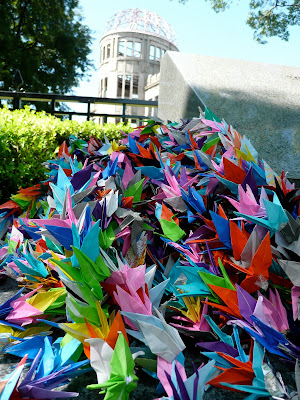I've been teaching in Japan for three years now, and by and large my classes are a pleasure. In addition to my classes, students have other lessons with Japanese teachers who teach them the grammar and mechanics of the English language. Those teachers are the unlucky ones, teaching the kids all the necessary boring stuff. I'm the lucky one — my classes are the ones where the kids actually get the chance to use what they've learned — to finally speak instead of just listen.
This can be a lot of fun! And... it can also be terribly painful.
Classroom management in Japan was a real adjustment for me. The expectations for student behavior in the classroom are very different from the U.S. and weren't immediately clear to me.
First off, you should know that the standard Japanese class has 40 students. This I'm sure would make American teachers choke on their coffee, given how much noise they make about having even 30 students in a class. All the students are divided up into homeroom classes, and they take nearly every class with the same cohort of kids.
Luckily for me, however, each class is divided in half for English lessons, so I teach only 20 kids at a time. Over the course my time here, I've been tasked with planning lessons ranging anywhere from 35 to 65 minutes.
My very first lessons were kind of a trial by fire where I got a glimpse into the challenges that lay ahead for me as an English teacher. Essentially, I'd been told to give an introduction of myself, showing pictures and explaining (very slowly) where I was from, some personal details, my hobbies, whatever. Then students would have a chance to ask me some questions. Picturing how this kind of lesson would have been received by American students meeting a foreigner from a strange place for the first time, I was fully prepared to field an onslaught of questions from a bunch of bright-eyed curious youngsters.
Except that when the question period came, repeatedly I was greeted with only a bunch of stares. Nobody had questions? Really?!...
Well, no, not really. The kids were full of questions, I have no doubt. But they just didn't know how to ask them. Or they were too afraid to ask them.
You know that old adage "If you can't say anything nice, don't say anything at all"? For the Japanese, the philosophy goes more like, "If you can't say anything right, don't say anything at all." The problem is the students know their English isn't perfect, and rather than speak up and make a mistake, they'd rather remain silent.
They're also simply not used to speaking up in class at all. I remember one time I was reviewing the names of places on a map before doing an activity on giving directions. I pointed to the park on a map and asked them the English word for it. Silence. Four years of English education under their belts and no one can manage to say the word "park"? Come on! Sometimes this can be really frustrating.
I can think of no better example of this phenomenon than the recitation assignment all my sophomores were given last year. They were made to memorize a passage from their textbook and recite it in front of class. These recitations took one to two minutes. This was a challenging task for the kids, as I'm sure you can understand. It probably would have been hard enough to do this kind of public speaking task in Japanese, let alone English.
So a lot of kids got up in front of class, began doing their thing and inevitably hit a point where they had a hard time remembering the next line. They'd stand there nervously, eyes squeezed shut, biting their lip, desperately trying to will the words into their memory. I felt bad for them.
The thing is, I know that if American kids had to do an assignment like this, it would be only a matter of time before some clown, recognizing the futility of recalling the words, would just start making stuff up. He'd say something ridiculous, the entire class would laugh, everyone would relax a bit and remind themselves of the absurdity of the task.
Three hundred and twenty Japanese students gave me their recitations. Lots of kids hit a point where they just couldn't remember it anymore, and stood there silently for the next minute and a half until their time was up. Not one attempted to ham it up. No one winged it and tried to just make something up that sort of half-resembled the actual script. I wonder if the thought even occurred to them. Honestly, after listening to days of endless droning about Charlie Brown buttering toast, I would have happily handed a high score to any kid who deviated even slightly from the script in the name of a laugh.
But it went down the way it did because in the Japanese mind, it's better to say nothing than to say the wrong thing. It's better to have forgotten the script than to give the appearance of not knowing it, or of having memorized the wrong thing.
In this way, I have to admire my Japanese students. They are so earnest, so dedicated. They take their studies seriously. A lot of American students could stand to take a cue from them.
At the same time, it's this drive for perfection that also holds them back. I always tell my students, "Don't be afraid to make mistakes!" Nobody expects them to be perfect — except themselves! Getting them to overcome this fear is my biggest challenge as a teacher.
Part of the problem is that the Japanese school system enables this reluctance to take risks. You might think, "Oh, no problem, kids won't volunteer to answer questions in class? Then just pick someone to do it." But it's not that easy. In Japan, if a student isn't sure of an answer, there is no expectation that he'll try to answer anyway. He can simply deflect the question by saying "Pass". A lot of them don't even do that, though. I will pick certain students to answer something, and they will simply not respond at all. They will just sit there, silent. I didn't understand this was how it works when I first started teaching. A Japanese teacher would have recognized that a student didn't know the answer and simply moved on. But I just stood there, waiting for an answer. Waiting for some kind of recognition that I even just spoke to them. There'd be a terrible awkward silence where they'd stare down at their desk and I'd wonder if they were just trying to think of the answer or what. When they said nothing, inside I was very irritated. Their silence seemed terribly insubordinate. This wouldn't be tolerated in America.
Once I understood the cultural difference, I stopped being upset by this behavior. But it does sometimes present a challenge teaching the type of interactive lessons I'm tasked with doing, where students are expected to speak, listen, understand and respond.
My school doesn't allow teachers to give out candy as incentives. Instead, I followed in the footsteps of my predecessor and award the kids stamps each time they speak in class, whether they say the right thing or not. Students know that the participation stamps they accumulate during the semester factor into their final grade. Initially the problem with this was that the head English teacher wouldn't tell me, much less the students, exactly how the stamps would be factored into their final grade. It seemed like they didn't want to place a value on the participation stamps until the end of the semester when they could see how all the kids' grades were shaping up. Consequently, the motivating power of the stamps was severely diminished. (Well, it's that and the fact that grades just don't matter as much here. Kids know that as long as they score well on their college entrance exams, mediocre grades won't hurt them.)
Since I couldn't entice my students with candy, and it didn't work so well making vague promises about the participation points boosting their grade, I turned to all-out bribery. When Joe and I visited home last year, I returned with a bag stuffed full of little souvenirs — pennies, postage stamps, English pins with edgy messages, buckeyes, miniature American flags, Obama campaign stickers, and the mother lode — Obama campaign buttons I ordered from
Democratic Stuff, a company in Greenville, Ohio, that produces campaign products. I showed the stuff to the students and told them that the five students from each class with the most participation points at the end of the semester could choose a prize. When I gave those prizes out, the kids went absolutely bonkers over the Obama buttons. Finally I'd found a successful motivator! A lot of them may not care about learning English, but they care about winning some Obama memorabilia.
I suppose if I did that in the U.S. that'd make me a "Socialist!", but here it just makes me popular.
 Well, this is it! Joe and I are flying out of Japan tomorrow morning, so this will be my final blog post. A lot of mixed feelings right now — sadness that this journey is coming to an end, excitement about moving back, being near family and resuming a life where certain everyday things are less of a challenge.
Well, this is it! Joe and I are flying out of Japan tomorrow morning, so this will be my final blog post. A lot of mixed feelings right now — sadness that this journey is coming to an end, excitement about moving back, being near family and resuming a life where certain everyday things are less of a challenge.































































